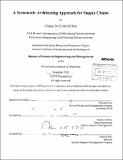| dc.contributor.advisor | Charles H. Fine. | en_US |
| dc.contributor.author | Kao, Chung-En | en_US |
| dc.contributor.other | System Design and Management Program. | en_US |
| dc.date.accessioned | 2011-12-09T21:23:09Z | |
| dc.date.available | 2011-12-09T21:23:09Z | |
| dc.date.copyright | 2010 | en_US |
| dc.date.issued | 2011 | en_US |
| dc.identifier.uri | http://hdl.handle.net/1721.1/67555 | |
| dc.description | Thesis (S.M. in Engineering and Management)--Massachusetts Institute of Technology, Engineering Systems Division, System Design and Management Program, June 2011. | en_US |
| dc.description | Cataloged from PDF version of thesis. | en_US |
| dc.description | Includes bibliographical references (p. 76-81). | en_US |
| dc.description.abstract | Over the past two decades, the advent of information and communication technology has broken physical distance limits and enabled seamless collaboration models, real-time planning, and quick responses among participants in supply chain systems. Globalization, specification, and the use of technologies that pursue low costs with high services have been dominating the supply chain design for years. Since 9/11 in 2001, however, supply chain designs have shifted from concentrating on cost-competitive advantages to security, collaboration, robustness, and flexibility. After 2008, worldwide events such as fluctuating gasoline prices, increased labor costs in developing countries, volatile demand as a result of the economic recession, and environmental regulations and agreements have resulted in renewed scrutiny of supply chain design paradigms. These challenges not only have had an impact on supply chain operations, but also on its architecture: in the aspects of organization, culture, geography, and information. Obviously, expanding globalization has made it difficult to consider a system locally and closely. The interactions between internal and external stimulus, multiple stakeholders' goals, along with corporate bottom lines: sociality, plant, and profits have conducted a supply chain a complex system. In order to resolve this complexity, to understand the supply chain holistically, and to avoid applying a complex solution on a complex supply chain system, a supply chain architecting framework, derived from Systems Engineering and System Architecture, is proposed in this research to simplify the supply chain architecting process into steps: modeling, mapping, and linking operational and architectural improvements. In summary, the goals of this study are: (1) Eliminate the gaps between corporate (supply chain) strategy, design, and implementation; (2) Propose a framework consisting of previous research and best practices; (3) Develop a simple, easy-to-understand, planning modeling methodology that carries sufficient information for supply chains. The contributions of this study aligned with these three goals are: (1) Supply chain architecting framework, including the fulfillment and value chains and the three improvement cycles; and (2) Architecting methodology, including concept, form, and function, as well as three layers of views from which to represent a supply chain. | en_US |
| dc.description.statementofresponsibility | by Chung-En (Conrad) Kao. | en_US |
| dc.format.extent | 81 p. | en_US |
| dc.language.iso | eng | en_US |
| dc.publisher | Massachusetts Institute of Technology | en_US |
| dc.rights | M.I.T. theses are protected by
copyright. They may be viewed from this source for any purpose, but
reproduction or distribution in any format is prohibited without written
permission. See provided URL for inquiries about permission. | en_US |
| dc.rights.uri | http://dspace.mit.edu/handle/1721.1/7582 | en_US |
| dc.subject | Engineering Systems Division. | en_US |
| dc.subject | System Design and Management Program. | en_US |
| dc.title | A systematic architecting approach for supply chains | en_US |
| dc.type | Thesis | en_US |
| dc.description.degree | S.M.in Engineering and Management | en_US |
| dc.contributor.department | System Design and Management Program. | en_US |
| dc.contributor.department | Massachusetts Institute of Technology. Engineering Systems Division | |
| dc.identifier.oclc | 761392382 | en_US |
